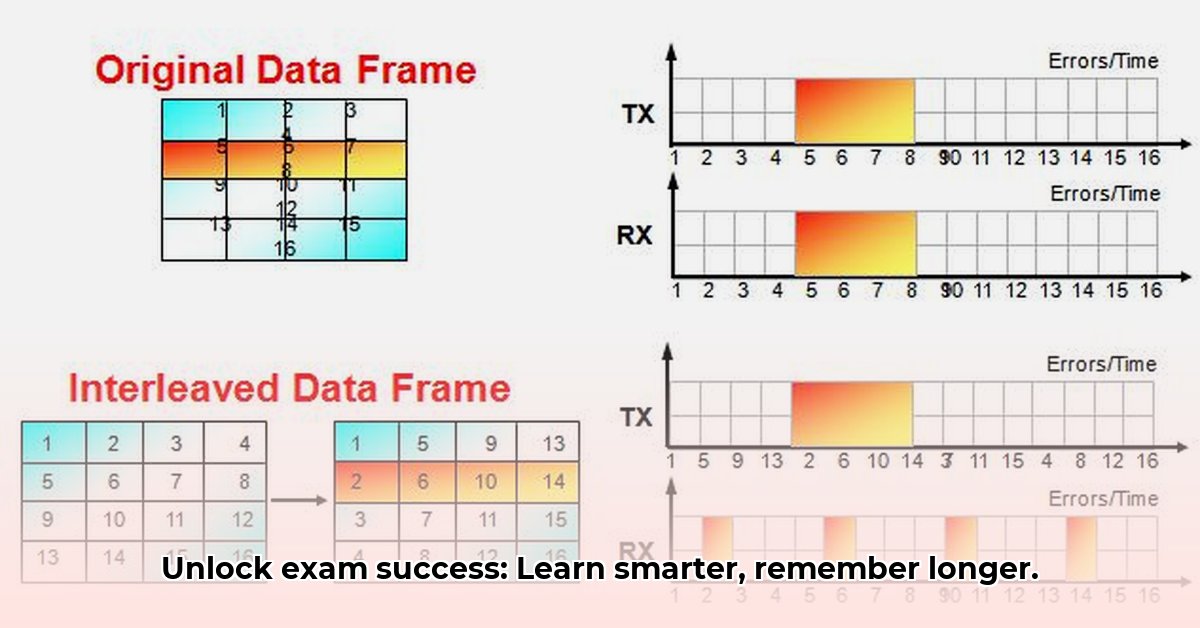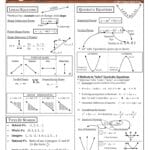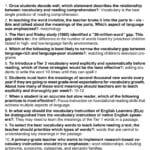Ever crammed for a test, aced it, then forgot everything? Many students struggle with remembering what they study. This guide reveals two study methods: blocking and interleaving. We’ll explain each, show how they work, and help you choose what’s best for you, allowing you to study smarter and remember what you learn! To further enhance retention, consider using spaced repetition.
Unlock Your Academic Potential: Interleaving and Blocking for Exam Success
Want to nail exams without all-nighters? The secret is how you organize study time. Interleaving and blocking are two powerful techniques – think of them as workout routines for your brain that boost knowledge retention. Let’s explore how to master these study techniques effectively.
Decoding Interleaving: The Power of Mixing Subjects for Enhanced Learning
Imagine a workout routine switching between weightlifting, running, and swimming. That’s interleaving! Instead of focusing on one subject for hours, you hop between different topics. For instance, study history for an hour, then switch to math, then science, and back to history. While it might feel chaotic initially, the results are amazing. This technique enhances cognitive function and improves long-term recall.
- How it Works: Interleaving tricks your brain into working harder. It forces your brain to actively distinguish between different ideas, building stronger memory links and improving long-term recall. It’s like creating multiple paths to the same information – making it easier to access later, no matter the situation. This active discrimination strengthens neural pathways.
- The Upside: Studies suggest interleaving leads to significantly better long-term memory. You’ll likely apply what you’ve learned to new situations more easily, and you’re less prone to forgetting the material. This improves adaptability and application of knowledge. Interleaving promotes deeper understanding and robust recall.
- Real-World Example: Instead of three hours straight of chemistry, try interleaving it. Study chemistry for an hour, then tackle some physics problems, followed by a chapter of biology. This forces your brain to make more connections, leading to a deeper, more lasting understanding. This active recall boosts learning, leading to deeper comprehension. Employ varied practice questions to enhance engagement.
Understanding Blocking: Deep Dive into Focused Study
Blocking is the opposite of interleaving. It’s about focusing intensely on a single subject for a block of time before switching. Think of mastering one skill before moving on to the next. It is an efficient method for rapid skill acquisition, providing a dedicated focus.
- How it Works: By concentrating on one subject, you build quick proficiency and master specific details. You become efficient within that area in the short term, allowing for comprehensive understanding within a limited scope.
- The Perks: You’ll master individual concepts rapidly, and you’ll see quick improvement in your ability to perform specific tasks. It often feels easier and more efficient in the short term, building a sense of accomplishment quickly. Blocking can be less mentally taxing, offering a sense of immediate progress.
- Real-World Example: Devoting two hours solely to working through calculus problems, dedicating your attention to mastering specific types of problems. This approach allows for focused skill development.
The Study Skills Showdown: Interleaving vs. Blocking
Let’s compare these two approaches. Which one will improve exam performance and understanding skills? Understanding the strengths and weaknesses of each method provides adaptability in your studying techniques.
| Feature | Interleaving | Blocking |
|---|---|---|
| Immediate Results | Might feel harder at first; test scores may be lower initially | Feels easier; test scores may be higher right away |
| Long-Term Memory | Significantly better for lasting retention | Less effective for long-term recall |
| Adaptability/Application | Excellent for applying knowledge in new situations | More limited application; more likely to forget details |
| Best Suited For | Long-term learning goals, diverse subjects | Mastering individual, well-defined concepts quickly |
| Cognitive Engagement | High, requires active discrimination | Moderate, allows focused attention |
| Error Detection | Superior, promotes better error identification | Can lead to overlooking subtle errors |
Crafting Your Optimal Study Schedule: Integrating Interleaving and Blocking
So, which method reigns supreme in aiding cognitive processes? The truth is, it depends! While research strongly suggests interleaving is better for long-term retention, a smart combination of both can be incredibly effective. This combined approach creates a powerful study strategy. Embrace this hybrid approach to maximize your learning potential.
Your Step-by-Step Guide to a Killer Study Schedule:
- Assess Your Material: Are the concepts related or completely different? Understanding the relationship between topics helps you choose the right strategy. Consider the complexity and interdependency of the subjects.
- Define Your Goals: Are you aiming for short-term mastery or long-term retention? This influences your technique choice. Prioritize long-term retention where possible for comprehensive understanding.
- Pick Your Method: Start with blocking if you need to initially grasp a main idea. Then, shift to interleaving for solid, enduring retention. Use blocking to build a foundation, then interleaving to reinforce and expand.
- Build a Realistic Schedule: Combine interleaved subjects with focused blocking sessions as needed. Don’t try to do everything at once! Start small and build up gradually. Ensure sufficient time for both interleaved and blocked sessions.
- Review and Adapt: Keep track of your progress. Notice what feels most productive and adjust your schedule accordingly. Experiment! The key is to find a personalized strategy that adapts to your unique learning style.
Remember, consistency is key! Don’t be afraid to experiment with both methods to discover your ideal study rhythm. Successful students are adaptable. Be creative and find what unlocks your learning potential. There’s no one-size-fits-all answer – what works for one person might not work for another. The best approach involves discovering what feels right for you and sticking with it. Keep learning and growing! Adaptability and persistence will yield the best outcomes.
Boost Your Knowledge: Best Ways to Interleave Study Materials for Long-Term Retention
Want to remember what you study long after the exam’s over? Then you need to understand interleaving, a powerful technique that dramatically improves long-term retention. But how does it work, and how is it different from blocking? Let’s explore the nuances and benefits of these cognitive learning techniques.
Understanding Interleaving and Blocking in Cognitive Learning
Interleaving and blocking are two different approaches to organizing study sessions. Blocking involves focusing on one subject at a time, mastering it before moving to the next. Imagine practicing all your piano scales before attempting any melodies—that’s blocking. Interleaving mixes different subjects within a single study session. Think of practicing scales and melodies in short bursts, switching back and forth—that’s interleaving, encouraging cognitive flexibility. Adaptability is key for effective study sessions.
Unlocking Lasting Memory: Why Interleaving Works Better for Long-Term Retention
Numerous studies show interleaving trumps blocking for lasting memory. Why? Because it forces your brain to actively discriminate between concepts. When you switch between subjects, you’re constantly reminding your brain of the subtle differences, making them easier to recall later. This “desirable difficulty” makes learning more challenging initially but yields superior long-term results. It’s like building mental muscles, boosting knowledge retention. Interleaving creates robust neural connections.
Optimizing Learning: How to Effectively Interleave Study Materials
Here’s your step-by-step guide to implementing best ways to interleave study materials for long-term retention:
- Choose Related Subjects: Start with two closely related topics. Mixing unrelated topics isn’t as effective. The connections between topics amplify the benefits of interleaving.
- Set Short Study Intervals: Dedicate 20-30 minutes to each subject. Use a timer to maintain consistent intervals.
- Switch Regularly: After 20-30 minutes, switch to a different subject. Regular transitions enhance cognitive flexibility.
- Regular Review: Schedule regular review sessions to strengthen memory. Spaced repetition reinforces learning.
- Track Your Progress: Monitor your performance on practice questions. Adjust your approach as needed. Use performance data to refine your study strategy.
- Incorporate Active Recall: Test yourself frequently on the material from each subject. Active recall solidifies learning.
- Minimize Distractions: Create a focused study environment to maximize efficiency. Reduce interruptions to maintain concentration.
Example: If studying history and biology, you might spend 30 minutes on history, then 30 minutes on biology, then back to history, and so on. This technique is helpful in boosting your grades. Tailor your study schedule to accommodate your individual learning style.
Side-by-Side Comparison: Interleaving vs. Blocking
| Feature | Interleaving | Blocking |
|---|---|---|
| Initial Mastery | Slower, more challenging | Faster, easier |
| Long-Term Retention | Significantly better | Poorer |
| Cognitive Load | Higher | Lower |
| Best for | Long-term understanding, application | Quick mastery of individual concepts |
| Engagement | High, requires constant mental switching | Moderate, allows deep focus |
| Flexibility | Enhances adaptability to new problems | Limits adaptability to varied contexts |
Overcoming Challenges: Addressing Potential Drawbacks of Study Methods
Interleaving can feel harder initially because you don’t experience the immediate satisfaction of mastering one subject completely. However, the long-term benefits make the initial struggle worthwhile. Some find it helpful to start with a limited number of subjects to combat cognitive overload. Gradual implementation minimizes these difficulties.
Essential Insights: Key Takeaways for Effective Learning
- Interleaving is a highly effective study method for long-term retention.
- It involves switching between different subjects during a single study session.
- Unlike blocking, which focuses on mastering one topic before moving to the next, interleaving encourages active discrimination between concepts.
- Start with closely related subjects and gradually increase complexity as understanding grows.
- Regular review is essential to solidifying your knowledge and improving cognitive skills.
- Interleaving enhances problem-solving abilities and adaptability.
- Combine interleaving with active recall and spaced repetition for optimal results.
Optimize Exam Performance: Expert Insights- Proven Tactics for Effective Study Sessions
Want to remember more of what you study? Then ditch the cram sessions and try a new technique! This isn’t about studying harder; it’s about studying smarter with interleaving. Let’s explore a powerful technique to improve academic performance: interleaving.
Decoding the Differences: Understanding Interleaving vs. Blocking
Imagine learning to play the piano. Blocking means practicing only scales for an hour, then only chords for another hour. Interleaving, on the other hand, means mixing up your practice—a few scales, then some chords, then some scales again. Which approach do you think will lead to better overall piano playing results? This technique boosts learning through varied practice.
Interleaving is strategically mixing different subjects or topics during study sessions. Blocking involves focusing on one subject at a time for extended periods. Both have their place, but interleaving reigns supreme for long-term knowledge retention and application. Interleaving mirrors real-world problem-solving.
Think of it like this: blocking builds a strong foundation in individual concepts, while interleaving helps you build bridges between them for improved skills. Mastering both allows for academic agility.
Unlocking Knowledge Retention: Why Interleaving Works Better
Numerous studies show that interleaving significantly improves long-term memory. Why? Because it forces your brain to actively discriminate between concepts. This strengthens your understanding of each subject and enhances your ability to apply that information in new situations. It’s like strengthening the connections between the different parts of your brain’s knowledge network, thus improving retention. Interleaving promotes deeper cognitive processing.
Blocking, while efficient for short-term mastery, can create a false sense of understanding. You might ace a quiz on one topic right after studying it, but weeks later, that knowledge might be hard to retrieve. The benefits of interleaving allows better learning. Interleaving prepares you for comprehensive exams.
Utilizing Study Methods Practically: How to Implement Interleaving
Here’s how to strategically integrate interleaving into your Expert Insights- Proven Tactics for Effective Study Sessions:
Step 1: Plan Your Interleaving Session: Decide on 2-3 related subjects you want to study. Selecting related subjects optimizes the benefits of interleaving.
Step 2: Set Time Blocks: Allocate specific time slots for each subject (e.g., 20 minutes of math, 20 minutes of history, 20 minutes of science). Shorter, focused intervals maximize retention.
Step 3: Mix It Up: Cycle through your subjects, alternating between them within your study session. Don’t spend too long on any single subject before switching. Regular switching keeps your brain engaged.
Step 4: Repeat and Refine: Review and adjust your study plan based on your progress and understanding. What mix works best for you? Personalization is key to effective learning.
Example: For a one-hour study session:
| Time | Subject |
|---|---|
| 0:00-0:20 | Math |
| 0:20-0:40 | History |
| 0:40-1:00 | Science |
Remember, closely related subjects are the easiest to interleave successfully. This enhances learning and promotes cognitive connections.
Combining Techniques: Interleaving and Blocking with a Balanced Approach
While interleaving excels in long-term retention, blocking can be beneficial for grasping complex or challenging concepts initially. Consider using blocking for initial learning, then transitioning to interleaving for strengthening and retention. Experiment to find the right balance for you to help your academic success. This integrated approach offers comprehensive benefits.
Study Insights: Key Takeaways
- Interleaving, the strategic mixing of study subjects, significantly improves long-term retention and the ability to apply what you’ve learned.
- Blocking, focusing on one subject at a time, is useful for initial mastery but may not be as effective for long-term understanding.
- A combination of both interleaving and blocking is often optimal. Use blocking to solidify foundational concepts, then switch to interleaving to deepen understanding and retention.
- Experiment to find the balance that works best with your learning style and the material you’re studying. Regularly review and adjust your study plan.
- To ace exams, focus on strategic learning that facilitates retention and application of knowledge. The results will speak for themselves. Adaptability is crucial for academic success.
- Incorporate active recall and spaced repetition to further enhance learning outcomes.
- Remember that learning is a journey, and consistency is key.
Improve Your Study Plan: Community-Verified Strategies- How to Structure Study Sessions for Maximum Effect
Want to ace your exams without burning the midnight oil? The secret isn’t studying more, but studying smarter with these time management skills. Let’s explore two powerful techniques backed by research: interleaving and blocking. These Community-Verified Strategies- How to Structure Study Sessions for Maximum Effect will transform how you learn.
Deciphering Learning: Understanding Interleaving and Blocking
Imagine you’re learning to play the piano. Blocking means practicing one piece repeatedly until you master it. Interleaving, on the other hand, involves switching between different pieces throughout your practice session. Which approach helps you learn and remember better in the long run? Research overwhelmingly points to interleaving, enhancing cognitive ability and promoting robust learning.
Interleaving forces your brain to actively discriminate between different concepts. This strengthens memory pathways and improves your ability to recall information later. Blocking, while initially feeling easier, can create a false sense of mastery and improve the learning process. It’s like practicing only scales – you might become excellent at scales, but struggle when playing a full song. Interleaving enhances versatility and adaptability.
Making the Most of Study Time: How to Interleave Your Studies
Interleaving isn’t just for musical instruments; it’s a game-changer for academics. Here’s how to put it into practice for a better study plan:
-
Identify your topics: Break down your study material into distinct chunks. For example, if you’re studying biology, separate topics like cell structure, photosynthesis, and cellular respiration. The more defined the chunks, the more effective interleaving becomes.
-
Create an interleaved schedule: Instead of focusing on one topic for an extended period, create a study schedule that alternates between subjects. For instance, spend 25 minutes on cell structure, 25 minutes on photosynthesis, and then 25 minutes on cellular respiration. Repeat this cycle. Use a timer to maintain consistent intervals.
-
Mix it up: Don’t just alternate between two topics. The more subjects you interleave, the more effective the technique becomes for memory and learning. Increasing variety enhances cognitive engagement.
-
Vary your activities: Mix active recall techniques (like flashcards or practice questions) with passive review methods. Active methods boost retention.
-
Regularly review: Regularly revise past topics as you continue with interleaved study. This reinforcement is essential for retaining knowledge better. Spaced repetition reinforces long-term learning.
-
Incorporate Practice Problems: Regularly solve practice problems related to each topic. Apply knowledge to solidify understanding.
-
Reflect on Learning: Take brief moments to reflect on what you’ve learned in each session. Reflection promotes deeper understanding.
Utilizing Focused Study: How to Block Your Studies
While interleaving is generally superior for long-term retention, blocking can also be beneficial in some areas. Blocking is most effective for initial concept mastery or when focusing on particularly challenging topics requiring focused attention in your study method. Blocking provides deep, concentrated focus.
-
Choose a focused topic: Select a complex or challenging concept that requires deep understanding to make the most of your focused study. Address intricate topics with dedicated attention.
-
Allocate focused time: Dedicate a consistent block of time – for example, one or two hours – to studying this topic exclusively. Ensure uninterrupted study time.
-
Ensure active learning: Use active recall techniques to avoid passive reading. Practice problems, flashcards, concept mapping – these are your friends. Don’t just read; engage with the material for better comprehension. Engagement enhances understanding.
-
Take breaks: Even with blocking methods, regular breaks are crucial to prevent cognitive fatigue and allow the brain to rest. Breaks prevent cognitive overload.
Comparative Analysis: Interleaving vs. Blocking
| Feature | Interleaving | Blocking |
|---|---|---|
| Approach | Alternating between different topics | Focusing on one topic at a time |
| Effectiveness | Superior for long-term retention | Effective for initial mastery, complex topics |
| Effort | Requires more mental effort initially | Can feel easier initially |
| Best for | Broad understanding, long-term retention | Deep understanding of a specific concept |
| Memory Encoding | Enhanced memory consolidation | Focused memory encoding |
| Cognitive Flexibility | Promotes greater mental agility | Can limit mental agility |
Strategy Keys: Key Takeaways
- Interleaving significantly enhances long-term retention. Think of it as a mental workout that strengthens your memory muscles.
- Blocking is useful for mastering challenging concepts, but should be followed by interleaving to reinforce learning and improve skills.
- The most effective study sessions combine both interleaving and blocking, leveraging the strengths of each for a great outcome.
- Regular review and spaced repetition are vital for maximizing the benefits of both strategies.
- Active learning techniques are critical in both interleaving and blocking sessions, enhancing comprehension and retention in any study plan.
- Prioritize personalized learning strategies for optimal academic success.
- Consistency, adaptability, and active learning form the cornerstone of any effective study plan.
1 https://www.learningscientists.org/blog/2017/4/20-1














